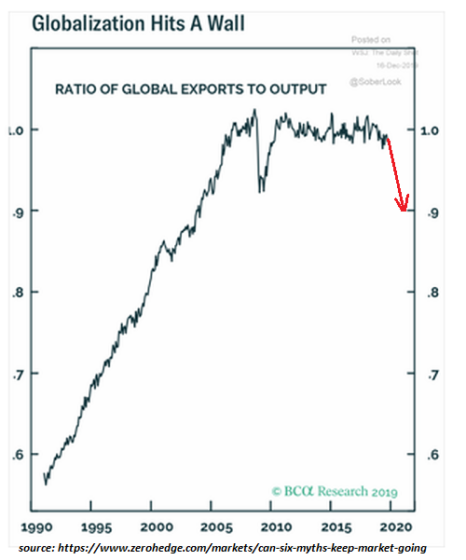
Be careful what you wish for, because currencies are not abstractions we ponder, they are commodities that serve real-world functions that put needs on the currency as a mechanism of trade, trust, worth and danger.
The present informing of the story of de-dollarization— the replacement of the United States dollar as the international economy’s primary reserve currency with a brand-new BRIC (Brazil, Russia, India, China) funded reserve currency–depicts the loss of the reserve currency as a disaster that will squash America.
As delightful as this possibility might be to various audiences, when we shift from considering a reserve currency as an abstraction to a system of trade and financing, then another result takes shape: supporting a reserve currency is a problem, and lifting that problem from the US will benefit the United States and hurt mercantilist exporting nations.
As a perk, it will likewise move the problem of supporting a reserve currency to the BRIC participants, who will then need to do what the US has done for years:
1. Export their brand-new reserve currency in size by running vast, continual trade deficits, for the only way a reserve currency can work exists is sufficient amounts of it drifting around as a transparently traded, market-priced commodity to grease trade and financing.
2. End up being the dumping ground for the world’s surplus production of items and services as the methods to run the large, sustained trade deficits that are the opposite of exporting currency so others can utilize it in international trade.
Numerous analysts such as Mish Shedlock and Michael Pettis have actually described these systems of reserve currencies and mentioned that being alleviated of the concern of supporting the primary reserve currency would be a great long-term benefit to the US. I have discussed Triffin’s Paradox for many years, the reality that no currency can serve both the domestic economy and the international economy (i.e. be a reserve currency) as releasing a reserve currency needs running trade deficits as a way of exporting trillions of units of the currency for use by others.
Comprehending the “Expensive Privilege” of the U.S. Dollar (November 19, 2012)
What Will Benefit from Global Recession? The U.S. Dollar (October 9, 2012)
In a comparable style, advocates of a gold-backed currency view such a currency as an abstraction without thinking about the real mechanics of backing a currency with a tangible product. The currency isn’t really “backed” by the commodity unless it can be converted into the commodity upon need. A currency is just “backed by gold” if there is a conversion system in which the holder of the currency can trade the currency for the comparable quantity of gold.
This is the only system that counts. Waving around the expression “backed by gold” does not turn a fiat currency backed by nothing concrete into a currency backed by gold unless that currency can be transformed into gold upon demand.
Contrarian Thoughts on the Petro-Yuan and Gold-Backed Currencies (January 19, 2023)
You Desired Really “Sound Cash”? A Thought Experiment (January 24, 2023)
So let’s think this through a bit rather than state on abstractions. Let’s state the US loses its reserve status; nobody desires the USD anymore and so nobody will trade goods and services for dollars. That suggests the United States can only import as much as it exports, i.e. a trade balance.
According to the Bureau of Economic Analysis (BEA), the United States exports about $3 trillion of goods and services and imports about $4 trillion. So once surplus imports can no longer be bought with dollars, that surplus $1 trillion in sales to mercantilist economies like China disappears.
Globalists love to weep and gnash their teeth over the fact that expenses of products made in the US will be greater than in sweatshops overseas. But globalists never think about quality, which has actually been declining given that globalization took the world by the throat. Let’s do the math: an inadequately made imported product that only lasts a year prior to it should be changed expenses $25. This product costs $50 when produced in the US.
Oh, boo-hoo, right? Not so quickly.
If the locally produced item lasts 5 years, the total expense over 5 years is $50. The total cost of the substandard imported product is 5 X $25 or $125. The domestic item is much, more affordable when we broaden the time frame to the whole life time of the item.
Stainless Steal (February 26, 2023)
Who’s going to be weeping genuine tears of distress are all the mercantilist economies that have dumped their surplus production in the United States for years, as there is no alternative economy large enough to soak up the $1 trillion in (primarily inferior) goods and services that the United States will no longer buy.
The issuers of the new reserve currency will have to run enormous, continual trade deficits to export enough of their new currency to meet the needs of a reserve currency and they’ll need to let the price of the brand-new currency float easily on worldwide markets, or it can not be depended maintain its value– a crucial attribute of a reserve currency.
If this new reserve currency is “backed by gold,” then nations that pile up the new currency in trade must be able to demand gold in exchange for the currency, as France required (and received) gold in exchange for its surplus US dollars in 1971. If the currency can’t be converted into gold, it’s not a gold-backed currency. It’s only backed by, well, absolutely nothing, similar to all the other fiat currencies.
Actually, fiat currencies are backed by something: interest-paying bonds. The greater the interest and the lower the threat profile of the bonds, the greater demand for that currency above others with riskier profiles and lower rates of return on the bonds.
This causes a paradox: the US dollar will become far more valuable once it is no longer a reserve currency as it will no longer be exported in large quantities. US dollars will be scarce and will hence increase in worth.
Personally, I’m in favor of competition in currencies– the more the merrier. The more options offered on a transparent international market where all currencies are floating easily on market supply and demand, the much better for everybody.
However beware what you long for, due to the fact that currencies are not abstractions we consider, they are commodities that serve real-world functions that place needs on the currency as a mechanism of trade, trust, worth and risk.

Thank you, all who reacted so generously to my rattling of the pleading bowl this past weekend. I am honored and humbled by your assistance and motivation.
New Podcast: Turmoil Ahead As We Get In The New Period Of ‘Shortage’ (53 minutes)
 My brand-new book is now offered at a 10% discount ($8.95 ebook, $18 print): Self-Reliance in the 21st Century.
My brand-new book is now offered at a 10% discount ($8.95 ebook, $18 print): Self-Reliance in the 21st Century.
Read the very first chapter free of charge (PDF)
Read excerpts of all 3 chapters
Podcast with Richard Bonugli: Self Dependence in the 21st Century (43 minutes)
My current books:
The Asian Heroine Who Seduced Me (Unique) print $10.95, Kindle $6.95 Read an excerpt for free (PDF)
When You Can’t Go On: Burnout, Numeration and Renewal $18 print, $8.95 Kindle ebook; audiobook Read the very first section free of charge (PDF)
Worldwide Crisis, National Renewal: A (Revolutionary) Grand Strategy for the United States (Kindle $9.95, print $24, audiobook) Check Out Chapter One totally free (PDF).
A Hacker’s Teleology: Sharing the Wealth of Our Shrinking World (Kindle $8.95, print $20, audiobook $17.46) Check out the very first section free of charge (PDF).
Will You Be Richer or Poorer?: Revenue, Power, and AI in a Shocked World
(Kindle $5, print $10, audiobook) Read the first area free of charge (PDF).
The Adventures of the Consulting Philosopher: The Disappearance of Drake (Novel) $4.95 Kindle, $10.95 print); checked out the very first chapters for free (PDF)
Cash and Work Unchained $6.95 Kindle, $15 print) Read the first section totally free
Become a $1/month patron of my work via patreon.com.
KEEP IN MIND: Contributions/subscriptions are acknowledged in the order got. Your name and e-mail remain personal and will not be provided to any other specific, company or agency.
|
Thank you, Michael M. ($50), for your superbly generous contribution to this website– I am greatly honored by your steadfast assistance and readership. |
Thank you |
, Mars K. ($5/month), for your marvelously generous contribution to this site– I am significantly honored by your unfaltering assistance and readership. |

